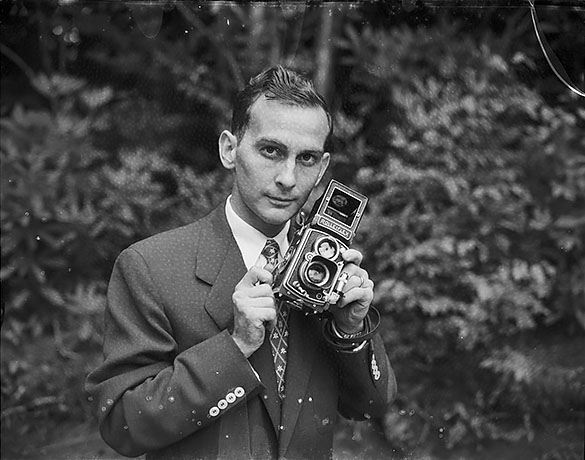
This morning’s Charlotte Observer reported that longtime Charlotte News photographer Jeep Hunter passed away yesterday at the age of 91. Hugh Morton made the above portrait of Hunter circa the 1950s. The negative is a deteriorated acetate negative, which is why the image has a mottled look and a crease in the upper right corner.
Category: Biography
A personal look back in time on a very special day

On February 19, 2017, Hugh Morton would have turned 96 years old. And with this post, Hugh Morton collection volunteer and contributor Jack Hilliard is celebrating a personal “View to Hugh” milestone.
. . . you could not contain him [Hugh Morton]. . . There was never any negativism. He was creative, forward thinking. . . As a promoter, he was North Carolina’s best. His first love outside Grandfather Mountain was this place [UNC]. He loved this place with a passion.
Dr. William Friday, Windows (Fall 2007)
On February 19, 1921, 96 years ago today, Hugh MacRae Morton was born in Wilmington, North Carolina. Morton’s first published photograph appeared in Time when he was fourteen, and over the next seventy-plus years, he took well over two hundred thousand pictures of life in “his” North Carolina and beyond.
During World War II Morton was attached to the 37th Infantry Division where he was a newsreel cameraman and photographed the South Pacific Theater, including an occasion to photograph General Douglas MacArthur at Binalonan and San Manuel on Luzon Island in the Philippines. While on the island of Luzon, Morton was injured by a Japanese explosive. He was later awarded the Bronze Star and the Purple Heart.
Upon his return from the war, Morton picked up where he left off, taking pictures across his native state. His work has been featured in hundreds of publications including Life, National Geographic, Esquire, Saturday Evening Post, and Collier’s. Two magnificent books of his photographs have been published, so far…one in 2003 titled Hugh Morton’s North Carolina and a second one titled Hugh Morton: North Carolina Photographer, published soon after his death on June 1, 2006.
It was at his memorial service at First Presbyterian Church in Greensboro on June 9, 2006 that I learned from Dr. William Friday that Morton’s photographic archive was going to be donated to the University of North Carolina and was to become a part of the North Carolina Collection at Wilson Library on the UNC campus. My first thought was that the Library would most likely just store the boxes of photographs, negatives, and slides in a safe place. And that was a comforting feeling, knowing that the images would indeed be safe.
Then, in early fall of 2007, I received my copy of Windows, a UNC library publication published by the Friends of the Library. The lead, front-cover-story was about the Hugh Morton photography archive coming to the North Carolina Collection. The magazine called the estimated 530,000-item-collection a stunner and North Carolina Collection Curator Bob Anthony said it was the largest collection ever given to the library (to date).
The amazing article also indicated that the photographs would be cataloged, identified, and filed for easy use. North Carolina Collection archivist Stephen Fletcher along with his assistant Elizabeth Hull would lead a team of students and volunteers in doing the work. A sidebar article called “Processing the Morton Collection (Wrestling the Bear)” told of the challenges the team faced, since many of the photographs did not contain identifying captions. (Elizabeth wrote a blog post on the subject on November 7, 2007 titled “A Processor’s Perspective.”)
As I read through the article, I thought, “What a great job, going to work each day and your duties included looking at Hugh Morton photographs.” So I wrote Stephen and Elizabeth an email on December 12, 2007 and offered to help identify some of the football pictures since I have been a UNC fan since the age of 6. I received a reply that said the team had not gotten to the identifying point yet, but I might be able to help later. The article also mentioned the “processing blog” that offered readers an opportunity to comment. I immediately logged in and read each entry and comment starting with Fletcher’s first entry on November 1, 2007. Then on January 21, 2008 I added my first comment. I have continued to add comments when I thought I could offer something of interest.
When the 2008 football season started, I suggested a blog topic. Since Carolina was playing Notre Dame in Chapel Hill on October 11th, why not look back to the first meeting between the two teams in November of 1949. Morton’s pictures from that day are classic. Stephen accepted the idea and wrote two really good posts about the game: “The Tar Heels against the Fighting Irish in the Big Apple” and “Justice’s Prayer.”
When the processing team got to the point where they could begin identifying UNC football photographs, I received an email on October 8, 2008, asking if I would like to become a volunteer. Of course my answer was yes and I began to make weekly Friday visits to the collection starting on October 31, 2008. Each Friday there would be a group of negatives for me to try to identify. There was something exciting about holding the very negative that had been used to print a newspaper picture that, as a little kid, I had clipped out of the paper and pasted in a scrapbook. I continued those Friday visits until August 17, 2010, and I still make periodic visits to the North Carolina Collection Photographic Archives.
As the football season progressed, it looked like the 2008 Tar Heel team would be going to a bowl game, so I made a second suggestion: Why not do a piece on Carolina’s first bowl game played in the Sugar Bowl on January 1, 1947? Elizabeth liked the idea and added, “Why don’t you write it?” I was surprised, but agreed to do it, but only if Stephen and Elizabeth would carefully review and edit it. So on December 22, 2008 my first piece for “V2H” was posted . . . surprisingly enough with very little editing. At the time I made the suggestion, I thought that Morton photographed that game, but it turned out that weather conditions prevented him from getting there. Four years later, a post on December 28, 2012 revealed the “Morton mystery” surrounding the ’47 Sugar Bowl.
In early 2009, Elizabeth suggested that I do a piece on Morton’s run for governor. I did that piece, which was posted on March 24, 2009. By now I was really hooked and I started to look for ideas to write about—and surprisingly I found some. So, on this special day, the day Hugh Morton would have turned 96, this post is the 100th for me. With special thanks to Bob Anthony, Stephen Fletcher, and Elizabeth Hull . . . it has been a fun ride. I hope it can continue. It is indeed a genuine privilege and honor to help celebrate Hugh Morton’s magnificent photographic work.
Ida Howell Friday
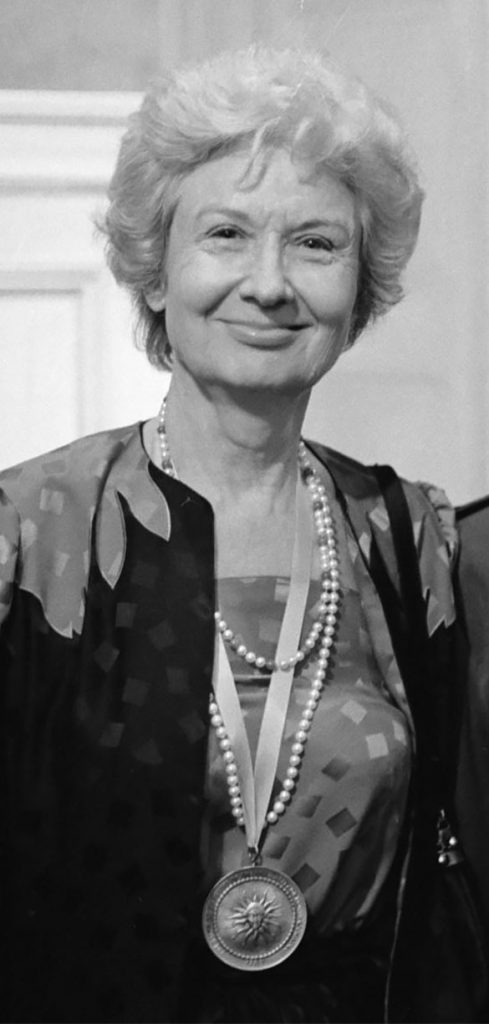
There is news today that Ida Howell Friday, widow of former UNC President William “Bill” Friday, passed away on Monday. She was 97. Bill Friday encouraged Hugh Morton to donate his photographic archive to the North Carolina Collection. There are a handful of images of Ida Friday in the online Hugh Morton collection, one of which can be seen below. An online obituary can be read at the News and Observer website.
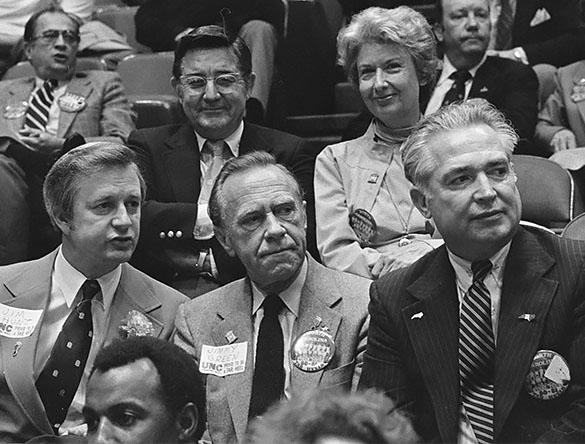
The 1971 environmental conference at Greensboro Coliseum

If we do not start treating our environment with more respect—giving it time to replenish itself—we are in for trouble in the future. —John H. Glenn Jr., October 12, 1971 at Douglas Municipal Airport, Charlotte, North Carolina
With John Glenn’s passing on December 8, I recalled the group portrait made by Hugh Morton at a campaign debt retirement party for Terry Sanford attended by Glenn and others. To see what, if any, other photographs Morton may have made of Glenn, I turned to the collection finding aid and found the following listing for fourteen 35mm black-and-white negatives: “Environmental Concerns #44: ‘Environmental Conference, Greensboro Coliseum: John Glenn, Stewart Udall, etc.,’ 1970s-1980s?”
Ah that tantalizing question mark . . . another Morton Mystery!
For those who don’t know, many newspapers on microfilm held by the North Carolina Collection have been digitized by newspapers.com. They can be viewed for free if you are on the UNC-Chapel Hill campus, otherwise you need to have a paid subscription. Searching the website quickly revealed that the conference occurred on October 12, 1971. On that day, the North Carolina Jaycees and possibly the North Carolina Conservation Council (only one source mentioned that organization) sponsored rallies in four airports across the state, capped off with an environmental conference that evening at eight o’clock in the Greensboro Coliseum. More time consuming, however, was piecing together various (sometimes conflicting) news reports to form a coherent picture of the day’s events. I don’t believe what follows, however, is the whole story so I encourage you to leave comments to help complete it. I sense that this post could lead to more on the topic of the environmental movement in North Carolina . . . and maybe even turn up more Morton Mysteries.
*****
Here are four points that provide some context for the story:
Conservationism into Environmentalism
The environmental conference and rallies occurred during the formative years of environmentalism in North Carolina, an era that began in 1967 according to Milton S. Heath Jr. and Alex L. Hess III in their essay “The Evolution of Modern North Carolina Environmental and Conservation Policy Legislation.” Preceding the “Environmental Era” was the “Conservation Era” that began at the turn of the twentieth century. Heath and Hess characterized the difference between these two periods in terms of state laws:
In North Carolina, the statutes that implemented . . . resource management programs at the state level contained policy statements that encouraged management and use of resources in contrast with the preambles of environmental-era statutes that stressed protection and preservation.
Hugh Morton’s life straddles that transition. His career includes a decade of service as a member of the North Carolina Board of Conservation and Development under governors W. Kerr Scott, William B. Umstead, and Luther H. Hodges from 1951 to 1961. It is during those years, too, that Morton begins to conserve and develop Grandfather Mountain.
Earth Day
The very first Earth Day was April 22, 1970. Before the end of the year, on December 2, the United States Government established the Environmental Protection Agency. The new agency was a consolidation of several entities within the federal government. This accomplishment stemmed from the recommendation of President Richard M. Nixon as part of his “Reorganization Plan No. 3 of 1970,” which he proposed to the Senate and the House of Representatives on July 9th. In that document Nixon noted, “Our national government today is not structured to make a coordinated attack on the pollutants which debase the air we breathe, the water we drink, and the land that grows our food. Indeed, the present governmental structure for dealing with environmental pollution often defies effective and concerted action.”
North Carolina Legislation
Nearly one year after the first Earth Day, on April 8, 1971, North Carolina Governor Robert Scott sent the General Assembly an environmental message accompanied by several related bills. The year saw the enactment of the North Carolina Environmental Policy Act of 1971, also known by the acronym “SEPA” (State Environmental Policy Act), and the state’s Environmental Bill of Rights, introduced by State Senator Hargrove “Skipper” Bowles. The latter was enacted on June 21, 1971. According to Heath and Hess, “the bill as introduced was drafted at Senator Bowles’ request by University of North Carolina Law School Professor Thomas Schoenbaum. The voters of the state approved the proposed constitutional amendment in the general election on November 7, 1972.”
Politics
The October 12, 1971 “Environmental Emphasis Day” (a phrase used by two of the newspapers consulted for this post, but only the Charlotte Observer used capital letters) took place during the very early phase of the campaign season for the upcoming 1972 North Carolina primary elections on May 6. Hugh Morton announced his gubernatorial candidacy for the Democratic Party on December 1, 1971.
*****
On September 23, 1971 North Carolina Jaycees president T. Avery Nye Jr. announced that Colonel John H. Glenn Jr. would be a keynote speaker at an environmental rally at 8:00 p.m. at the Greensboro Coliseum, Nye noted that other speakers would include Oregon’s Republican United States Senator Robert Packwood and former United States Secretary of the Interior Stewart Udall. The Jaycees described the upcoming event at the coliseum as the “first of its kind in the nation.” The Greensboro Daily News reported that the day would start with Glenn and Udall, “accompanied by announced candidates for governor of North Carolina,” making a “whistle-stop tour” of the state “traveling by private, executive-type aircraft” to rallies at airports in Asheville, Wilmington, Charlotte, and Raleigh-Durham. Packwood would unite with Udall and Glenn in Greensboro after the tour for the evening rally. North Carolina’s United States Senator B. Everett Jordon “and most other members of the state’s delegation to Congress and members of the state’s General Assembly” were expected to attend. Nye also encouraged the general public to attend, noting that no admission or parking fees would be charged. The rally, Nye said, “is being staged to give North Carolinians an opportunity to show their support for good environmental legislation.” Attendees were going to be asked to complete a questionnaire on state environmental problems, with the results to be distributed to legislators and members of Congress.
The choice of John Glenn, the celebrated astronaut who nearly a decade earlier had become the first American to orbit Earth, to be a keynote speaker for an environmental conference may seem puzzling to us today, but it was not so at the time. Glenn had recently chaired Ohio’s Citizens Task Force on Environmental Protection, a bipartisan task force announced by that state’s Governor-elect John J. Gilligan on November 25, 1970. The panel issued it’s final report in June 1971. After its publication, Glenn toured around the country promoting Ohio’s study as a model for other states.
Three subsequent articles provided more details about the upcoming event: one in the Asheville Citizen on Monday, October 4, the second in a Daily Tar Heel article published on October 8, and the third in the Asheville Citizen-Times on Sunday, October 10. The Asheville Citizen article’s headline read “Environment To Be Frequent Topic During October In North Carolina.” The article described several activities scheduled for the month, including the “statewide environmental rally” in Greensboro that would be preceded on the same day by four airport rallies in Raleigh-Durham, Wilmington, Charlotte, and Asheville. (This order would be the actual order of the tour.) In addition to listing the expected speakers and invited individuals for the evening rally, the article stated that a “30-minute brand new movie on North Carolina and its environment” would be shown that night.
According to the Daily Tar Heel article, the Jaycees’ event was now co-sponsored with the North Carolina Conservation Council—no other resource, however, mentions this. The day was to begin in Washington D.C., where Governor Bob Scott, Bowles, Udall, and Glenn would fly to Raleigh-Durham Airport for the first of the four airport rallies. Later in the day in Greensboro, all but one of the state’s congressmen would fly to Greensboro from Washington for the evening’s rally. According to the October 12 issue of the News and Observer, however, Governor Scott met the Glenn-Udall party at Raleigh-Durham Airport and then traveled with them to the subsequent rallies. Scott did not attend the Greensboro event; instead, he returned to Raleigh to celebrate his wife’s birthday.
The Citizen-Times article published just two days before the eventful day stated that the North Carolina Jaycees “put about a year of planning and hard work” into the event. Thad Woodard, the Jaycees’ state environmental chairman, said,
The rally provides an opportunity for people of the state who have been expressing interest in environmental problems to show the strength of conservationists and environmentalists in North Carolina. We believe these problems have to be approached both on a legislative and on an educational basis . . . and our legislators and educators need to know that people are genuinely interested in the environment.
The Citizen-TImes also informed readers that the airport visits were to be made in two six-passenger planes provided by First Union National Bank and Northwestern Bank.
*****
News coverage from the host cities’ newspapers shed light on some of the activities for the rallies held on October 12. The News and Observer assistant city editor Daniel C. Hoover covered the day’s events, but he did not describe much about the Raleigh-Durham airport rally. Hoover only wrote that Governor Scott “called on official in coastal counties to declare a moratorium on all permits to destroy dunes for development pending a study authorized by the general Assembly.” Hoover then quoted Scott, who said he would “propose, in the near future, to call together all county and municipal officials of our coastal counties, along with appropriate state officials, to explore solutions to existing and potential coastal problems.”
At the next stop, Ronald G. Dunn, staff writer for the Wilmington Morning Star estimated their airport crowd to be seventy-five people. John Glenn drew upon his experiences as an astronaut. He told those gathered that Earth is “in effect a spaceship on which the warning lights are on, so therefore, as spacemen we should take action immediately to save our environment.” He described the obviousness from space that Earth’s atmosphere is a very shallow layer and that America was likely among the world’s worst polluters. He also urged involvement, saying “People interest in the United States gets action, so get interested.” An accompanying UPI photograph with caption depicted Scott, Glenn, Udall and “gubernatorial aspirant Hargrove Bowles” at Raleigh-Durham rather than a scene from the Wilmington airport rally. Bowles was able to join the group because, as of the environmental emphasis day, he was the only officially declared candidate for governor.
Only thirty people attended the rally in Charlotte according to Charlotte Observer staff writer Susan Jetton. Perhaps as a result of the sparse attendance, Governor Scott said “efforts of decision-makers are not very successful without the active support of the people.” Glenn again drew attention to the “warning signals” of pollution that were appearing “on this space ship earth.” He added, “If we do not start treating our environment with more respect—giving it time to replenish itself—we are in for trouble in the future.”
The Asheville visit drew more than one hundred people, according to staff write Connie Blackwell. Glenn used the “warning lights” metaphor here, too, but Blackwell added that Glenn did not see himself as “one of the doom and gloom boys.” Bowles urged the approval of the Environmental Bill of Rights. Udall and Scott each addressed proposed aspects of the Tennessee Valley Authority project in western North Carolina, the Mills River Dam and Reservoir. Udall, noting his many visits to western North Carolina during the previous ten years, said he was there that day because “I don’t want to see North Carolina go down the same road” as California. He noted that his “attitudes have made about a 180-degree turn in the past ten years. It used to be if a dam was mentioned, I automatically thought it was a good idea. Now, my reaction would be that it should not be built.” He continued,
Industrialists came into these valleys years ago and said. “We’ll give you jobs, but we’ll ruin your mountain streams and stink up your pure air.” They accepted because jobs were so badly needed. Now we are beginning to realize that it didn’t have to be that way.
*****
Several newspapers and the Associated Press (AP) reported on the evening conference. David S. Greene of the Greensboro Daily News, report that the first speaker was Udall, who wrote that Udall described “North Carolina as a leading state in maintaining ‘the standard of living,'” but also one that needed to prevent further “despoilment of the environment.” Udall encouraged attendees to “Hold on to what you’ve got.” Udall referred specifically Bald Head Island, which he had seen during a flyover earlier in the day. The AP reported that private developers wanted to build a “plush resort” there and that environmentalists had asked the state to purchase it and maintain its natural state. Greene noted that the audience applauded when Udall “urged American to listen to young environmentalists.” Quoting Udall: “If they have something to contribute let them contribute. It’s their world.”
The News and Observer reported that Udall, as “the keynote speaker,” suggested that Bald Head Island be added to the existing Cape Lookout National Seashore. He added during a press conference following the rally that there was “a hang-up” on how to pay for the acquisition. Hoover wrote that Udall continued by offering a few options “as prospective gubernatorial candidate Hugh Morton hovered at his shoulder snapping pictures.”

Senator B. Everett Jordan then introduced John Glenn, first noting legislation to reduce automobile exhaust and the problem of “one hundred million automobile tires lying around our countryside” plus twenty-eight billion bottles, a like number of cans, and millions of tons of paper products. Jordan then encouraged the audience to increase the recycling of products that have been seen as waste.
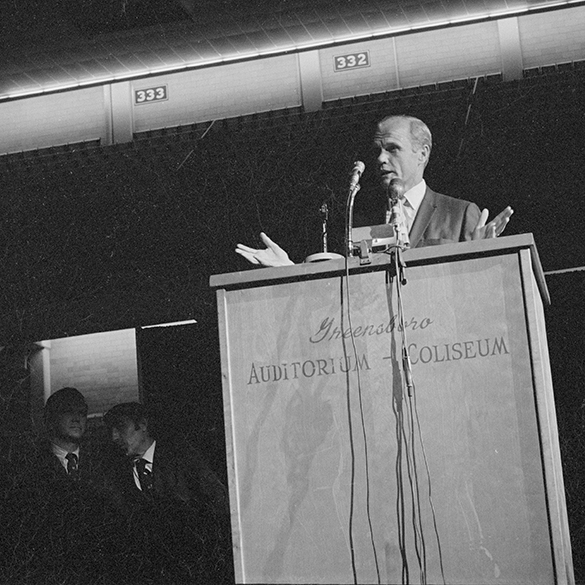
Recalling his orbital spaceflight John Glenn observed, “We do have closed loop systems that have to refurbish themselves, but we are, in fact, in danger of overtaxing our systems.” He said nature was waving “red flags” of warning and that “people power” was causing industry and government to take notice. That, in turn, he said “can generate the heat to get something done. People power, you bet.” He then dismissed the saying “the solution to pollution is dilution.” Glenn said, “We see the red flags going up . . . we better do something about it.”
Roy Sowers, director of the North Carolina Department of Natural Resources introduced Republican Senator Robert Packwood of Oregon, the concluding speaker. Packwood drew much attention and applause as he addressed measures that could advance population control. “I am committed,” he said, “to stopping this population binge, and reducing it, turning it around.”
*****
Despite the presence of so many politicians, the North Carolina Jaycees tried its best to keep the event from being political, according to Nat Walker in his “Political Notebook” column for the The Greensboro Daily News with the headline “Environmental Rally Becomes Political Gathering—Naturally.” Walker said, “They succeeded—sort of.” Only three North Carolina politicians got to speak from the rostrum—Bowles, Sowers, and Jordon—leaving the remaining “real or potential” candidates to “rely on mingling with the crowd or finding some excuse to stand in front of the audience.”
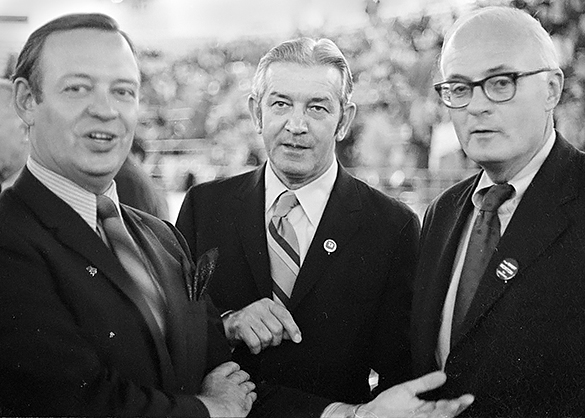
Mid October was an interesting time in Hugh Morton’s life. A month earlier, Morton attended the Governor’s Down-East Jamboree as a undeclared candidate for the 1972 Democratic Party primary. He would officially declare his candidacy on December 1. This meant that on October 12 Morton was still an “unofficial” candidate, and was not invited to participate in the flights to the airport rallies. Two newspapers reported specifically about Morton on that day. The Charlotte Observer characterized Morton as “unhappy.” In Charlotte, Morton said that he had, “done more in an environmental way than anyone now running for governor.” He acknowledged that being an unannounced candidate prevented him from participating. The Greensboro Daily News painted Morton as being in a different mood at the evening’s conference. Bowles, as an “announced” candidate for governor, got to introduce Udall because C. C. Cameron, a member of the state Board of Natural and Economic Resources, did not attend. Walker wrote that Morton “appeared miffed” and “pointedly noted that the Jaycees had extended him an invitation to attend the coliseum function.” Walker then recounted a scene where a “woman reporter” asked Morton when he would announce for governor. Morton snapped, “When I get ready.” Walker concluded that the reporter “Apparently couldn’t think of a follow up question and left red-faced.”
Wake Forest's finest golfer: Arnold Palmer (1929–2016)
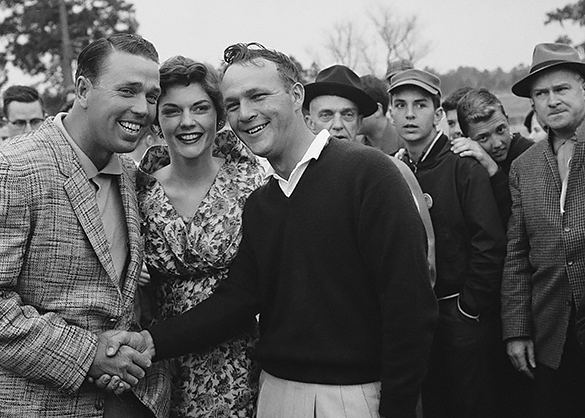
If I were to write a short story about this afternoon, I would title it “A Tale of Two Sweaters.”
Arnold Palmer, Wake Forest’s finest golfer who also was one of the game’s greatest players, course designers, and ambassadors, died yesterday. Earlier today, the Wilson Library reference staff received a request from a Wilmington media outlet for two images from the online collection of images of Palmer at the Azalea Open. Both images had dates of 31 March 1957; one scan came from a negative (cropped by the author) . . .
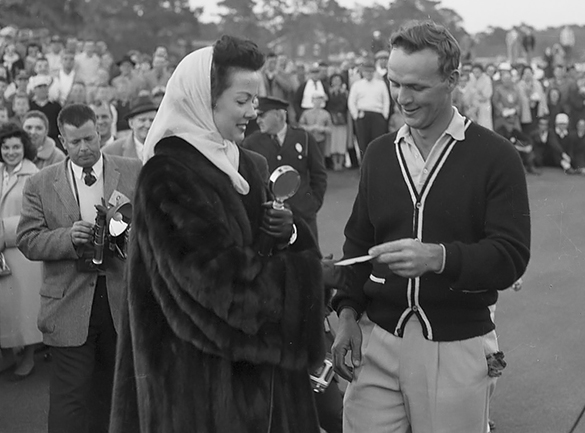
the other (below) from a print with no identifying information on its back.
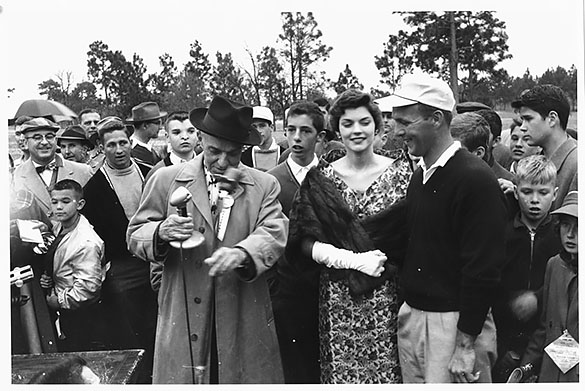
I quickly noticed that Palmer was not wearing the same sweater in both images, and that the women were also wearing different clothes. A bit of digging in newspapers on microfilm and online, plus a check with other Morton negatives that are not online (including the scan at the beginning of this post) led to the discovery that the first of these two images was correctly identified. It depicts the check presentation from Azalea Festival Queen Kathryn Grayson to Palmer after he won the 1957 open, but Morton made the latter after the 1958 tournament.
Here’s is the short storyline for the 1958 Azalea Open finale: Arnold Palmer was the defending champion, but finished second to Howie Johnson after losing a playoff round by one stroke. Palmer and Johnson were reportedly very good friends at the the time. The following week, Palmer won his first Masters Tournament in Augusta, Georgia.
Ironically, Palmer and Johnson died almost exactly one year apart: Howie Johnson died September 21, 2015.
Picture Day 1946: When Hugh met Charlie
The summer hiatus here at A View to Hugh is winding down as students begin appearing on campus this weekend. Hot August days have returned to Chapel Hill and football practice is underway for the 2016 season. Expectations are high for the Tar Heels just as it was seventy seasons ago. Today, on this anniversary of the birth of a very special friendship, Hugh Morton collection volunteer Jack Hilliard looks back to August 17, 1946.
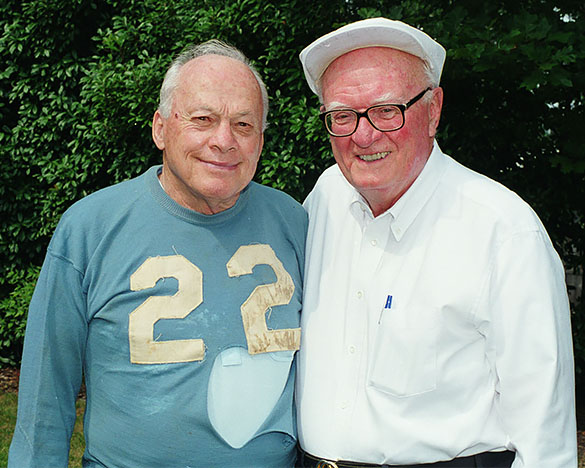
It was early August, 1946, and it was hot. The annual preseason football magazines had just hit the stands and judging from those traditional predictors, Carolina was going to be something special. Sportswriter Jack Troy wrote in the 1946 issue of Street & Smith Football Pictorial Yearbook:
. . . the Tar Heels are about ready to step back into the picture as a national football power. During the winter the Tar Heels snatched Charlie Justice from under the noses of South Carolina coaches, and Justice is supposed to be one of the best ball carriers in the business.
On August 17, 1946, Head Coach Carl Snavely greeted 104 Tar Heel candidates along with Kay Kyser, headline radio star and considered Carolina’s greatest all-time cheerleader. Also present was University President Dr. Frank Porter Graham. Of the 104, only 18 were returning lettermen, but Snavely said he expected about 10 additional lettermen by August 26th. By the time editor Jake Wade got the ’46 Football Media Guide published, the lettermen count was 31.
One of the most welcomed lettermen returning was Hosea Rodgers, a 200-pound fullback who led Carolina to a 9 to 6 victory over Pennsylvania back in 1943. Many of the freshmen were returning World War II veterans in their 20s—like freshman Charlie Justice, sometimes called the “Bainbridge Flash.” Justice was the one player who was going to make a good Carolina team great.
With the stage set, practice got underway. Although classes had not officially begun, there were many students already on campus. It wasn’t unusual for two or three hundred students to show up for Carolina’s practices. One of the early official team functions was called picture day, when the players dress out in their game day uniforms and talk with the media and pose for photographs. Of course one of those photographers present was Hugh Morton. Here’s how Justice described the scene that day for biographer Bob Terrell in a 1995 interview:
The first time I saw Hugh Morton was in August of 1946. The weather was hot and we were practicing twice a day. Sunday was an off day and Snavely and his staff decided that was the day they’d have the press come in and take pictures, get interviews, and so forth. . . We started at two o’clock, and it seemed that everybody in the country was there to shoot pictures. I noticed Hugh Morton on the sidelines, paying no attention to me at all, taking pictures of everybody else.
After about two and a half hours, Snavely said “that’s it guys,” and told the players they could go inside out of the heat. As the Tar Heels were leaving the field, UNC Publicity Director Robert Madry’s Assistant Jake Wade came over to Justice and said: “Charlie, I’d like for you to meet Hugh Morton. He’s a great friend of the University. He’d like to take a few more shots.” According to Justice, “We stayed there another two hours, hot as it was, and everything had to be just perfect.”
Finally Morton finished up and as the August sun was setting behind the west end zone, Charlie began the long walk to the Kenan Field House dressing room at the other end of Kenan Stadium. “I didn’t say anything at the time,” Justice said, ”but when I got in the dressing room, everybody had already left. I said, ‘I hope I never see him again.'”
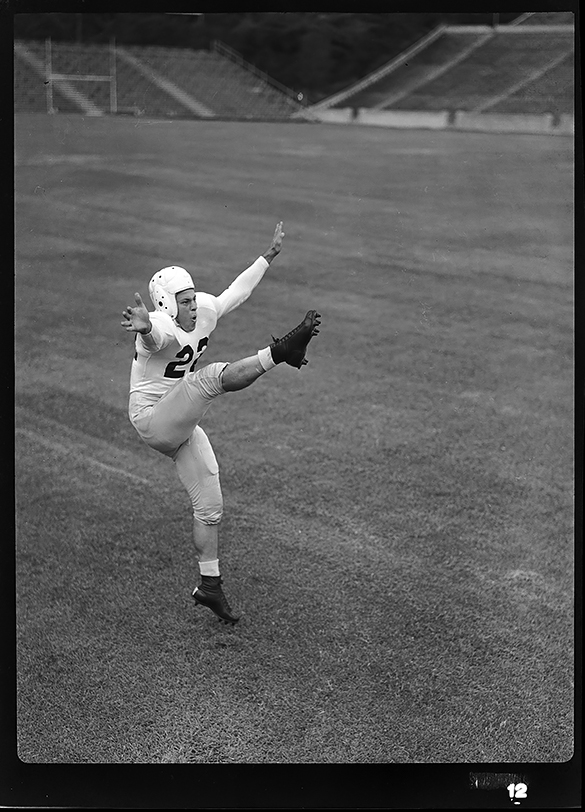
But Charlie did see Hugh again . . . often . . . at practice and on the Kenan sideline almost every Saturday afternoon. They would often carry on extended conversations, and in the end they became friends, a friendship that lasted 57 years. Justice often participated with Hugh at the Azalea Festival in Wilmington and at the Highland Games and other events at Grandfather Mountain. When Hugh Morton announced his candidacy for governor on December 1, 1971 Charlie Justice was with him in front of the Capitol in Raleigh.
“He supported me wholeheartedly,” said Justice, “not just at Carolina, either. When I got to the Redskins, I turned around on the field and there was Hugh shooting pictures. Because of him, I suppose my football career was preserved on film as well as anybody’s ever was. . . . When I went into the [College Football] Hall of Fame, he got Governor Luther Hodges’s plane and flew Sarah, me, and his wife Julia to New York—when we got there we discovered that the girls couldn’t got to the banquet. So Sarah and Julia went over to Broadway and saw My Fair Lady that night. Then we flew back to Raleigh.”
Justice treasured men like Hugh Morton as his friends, and the honor was returned. “We didn’t have ESPN or the Internet back then,” Justice said. “But we didn’t need ’em. We had Hugh Morton. What a great friend he was to our team and to Carolina.”

“I can close my eyes and still see him with that camera around his neck,” said Bob Cox, an end and place-kicker from the 1946 Tar Heels, “Hugh was always around the team, around the program. He gave meaning to what we were doing. If anyone ever stood for the Carolina tradition, it was Hugh Morton. He helped build the pride and spirit and love for Carolina as much as anyone on the team.”
On a day in late May of 2001, Hugh Morton, along with several Tar Heel friends visited Charlie and Sarah Justice at their home in Cherryville. Of course Hugh was taking pictures, but at one point he stopped and said, “Charlie Justice inspired more loyalty at a key time following the war that was reflected in a huge amount of support for every facet of the University, not just athletics. It would be impossible to put a value on his contributions to the University—it would be in the real big millions.”
On Monday, October 20, 2003, my wife Marla and I, along with 200 plus others, attended the memorial service for Charlie Justice at The Cathedral of All Souls in Asheville. We were seated on the right side of the church where we could see many of the special guests from the Tar Heel Nation seated in the center. Among that group was Hugh Morton. He, like all of us, was obviously emotionally shaken. I think it was the first and possibly the only time I ever saw him at a Charlie Justice event without his camera.
Morton "Uncommon Retrospective" opens in Raleigh

Today is the official opening of Photographs by Hugh Morton: An Uncommon Retrospective at the North Carolina Museum of History in Raleigh, North Carolina—the sixth venue for the exhibition since its debut in August 2013 at the Turchin Center for the Visual Arts at Appalachian State University in Boone. The exhibition will be at the museum for more than a year! Admission is free. If you are looking for ways to beat triple-digit heat index temperatures this weekend, a visit to the North Carolina Museum of History may be just the ticket. The exhibition looks terrific! The museum’s staff designed the exhibition to flow chronologically and several images sport new descriptive labels, so if you’ve seen the exhibition once before it is worth seeing it again.
There will be several programs related to the exhibition in the coming months, including “Hugh Morton, More Than Bridges and Bears” with Hugh Morton’s grandson Jack Morton and me in early December. I will post more about that event as the date draws near.
This is Living

Only experts take great photographs, and a great photograph (about as common as a great painting) is creative. Its impact is a stinging slap to the jaded or flagging attention. And its result will always be some deepened insight into the very nature of one aspect of this life that we are all, flower, man and beast, enjoying together on this our dusty, colorful planet home.
—Donald Culross Peattie in This is Living: A View of Nature with Photographs (1938)
June 1st, 2016 is the tenth anniversary of Hugh Morton’s passing. During the years that we have been writing for A View to Hugh, we have primarily featured Morton’s photographs of historical events from a factual perspective because that is the mainstay of the North Carolina Collection. Today, however, presents a marvelous opportunity to explore Morton’s nature photography—and following that link leads you to well over 700 photographs assigned that subject heading.
As you will see, certainly not every Morton photograph is great; there never has been, nor will there ever be, a photographer for whom this could be true. And even an amateur can make a great photograph now and then. Not every photograph, however, needs to be great. The trillions of photographs that we have made are micro expressions of singular moments in time. Hugh Morton was a gifted photographer who made many great photographs, many more good photographs, and many that were merely visual explorations along the way to making many good and great photographs. We are all honored that his prolific body of work is available in Wilson Library for all to utilize for our own explorations in life. There is great benefit to all in having one person’s lifelong photographic vision available beyond his or her place in time.
The opening quotation above comes from Donald Culross Peattie’s introduction to his commentary on more than 120 nature photographs by various photographers selected by Gordon Aymar. Most of the photographs are not great, some are far from it. Brought together, however, Aymar’s selection and sequencing of the photographs into chapters titled “Life-Force,” “Young Beginnings,” “Home,” “Living Together,” “Hunger,” Mysterious Ways,” “Death,” and “Life the Conqueror” leads readers through many photographic observations that celebrate living. Morton, with his ever-present camera, explored these very same categories, and more, in his nature photography.
On this tenth anniversary of Hugh Morton’s death, I invite you to explore his nature photography. Doing so will give you the opportunity to celebrate life as Morton saw it spanning seven decades through his eyes, cameras, and lenses. To quote Peattie once more:
It is a slender world in the cosmosphere that is set aside for us to inhabit—no more than the surface of one drifting bubble. The limits of life as we know it are terribly strict. Within these frail dimensions all living things are crowded, flung together in an intimacy that means struggle. We are conscripted to that struggle by the fact of birth, delivered from it, generally against our will, by death. This is living.
The other half of the hyphen
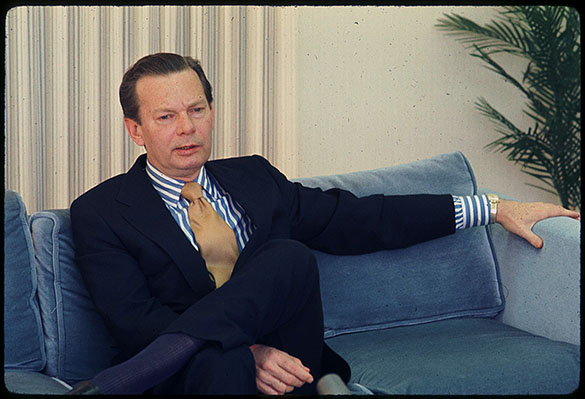
On April 24, 1988—twenty-eight years ago this week, Hall of Fame newsman and broadcaster David Brinkley (July 10, 1920 – June 11, 2003) delivered the Reed Sarratt Distinguished Lecture in Hill Hall on the University of North Carolina campus in Chapel Hill. Brinkley, a native of Wilmington, briefly attended UNC before joining the United States Army in 1940. In 1988 Brinkley was a commentator for ABC World News Tonight, but many in attendance that evening remembered him from his NBC News days as the “other half of the hyphen” on the Huntley–Brinkley Report from 1956 to 1970. Morton collection volunteer Jack Hilliard takes a look at the life and times of David Brinkley.
People have the illusion that all over the world, all the time, all kinds of fantastic things are happening. When in fact, over most of the world, most of the time, nothing is happening. —David Brinkley
One of my earliest TV memories is watching the evening news on CBS with my family in Asheboro, N. C. In the years 1951 and ’52 we had a 14-inch black-and-white General Electric model TV set. The news anchor was Douglas Edwards, but we didn’t know him as an anchor in those days. He was just the face on the screen. My dad often said he wished we could get the news on NBC because he had grown up with news on the radio with names like H. V. Kaltenborn, Ben Grauer, Morgan Beatty, and Bill Henry. But there wasn’t an NBC affiliated station in the Triad in those days. WFMY-TV in Greensboro was the only television station in the Greensboro–High Point–Winston-Salem market. So CBS was our only choice.
In the summer of 1952 we were able to see the Democratic and Republican parties’ national political conventions from Chicago, and the new face on CBS was a man with a funny last name: Walter Cronkite. Television had been at the 1948 conventions with a limited number of stations, but there weren’t many sets in use back then so that TV presence is nothing more than a historical footnote today. In ’52 things were different. Most everyone with a TV set watched the conventions, and the day-to-day happenings in Chicago became water-cooler conversations across the nation.
Then, on September 30, 1953, my dad got his wish—television station WSJS-TV in Winston-Salem, an NBC affiliate, signed on the air. (The station today is WXII-TV). Most of my dad’s NBC News favorites were there on The Camel News Caravan with John Cameron Swayze. In addition, there was also a reporter named David Brinkley.
Brinkley began his television career at NBC in 1951, having worked for United Press starting in 1943 following his military service in the army. One of Brinkley’s early NBC assignments was to cover President Harry Truman’s trip to Winston-Salem for the groundbreaking ceremony for Wake Forest College. (Hugh Morton attended that ceremony as well and we hope to write a post about the ceremony later this year in October.)
When it came time for the 1956 political conventions, NBC faced a major challenge. Walter Cronkite had set a high mark in ’52, so executives at NBC News looked for a way to compete with Cronkite. Their plan was to put in place two anchors for the broadcast. Originally they considered teaming Bill Henry with Ray Scherer, but the NBC brass ultimately decided on Chet Huntley and David Brinkley.

The double-team worked. It worked so well, in fact, that on October 29, 1956, the two-man-team took over the NBC evening newscast; thus was born the Huntley-Brinkley Report, with Chet Huntley in New York and David Brinkley in Washington. Brinkley’s dry wit and Huntley’s serious tone became the newscast to watch. Their catchphrase ending to each night’s broadcast was “Good night, Chet. Good night David. And Good Night for NBC News”—followed by the second movement of Beethoven’s Ninth Symphony as credits rolled.
The tandem proved to be a ratings’ winner. It was not until the late 1960s that CBS Evening News with Walter Cronkite finally caught up in the ratings’ race. From 1961 until 1963, David Brinkley added a magazine show to his resume called David Brinkley’s Journal. I remember how frustrated I was as a UNC student in 1961 when the local NBC station in the Triangle chose not to carry the program. The final Huntley–Brinkley Report aired on July 31, 1970 when Chet Huntley retired from NBC News.

On January 7, 1971, the city of Wilmington staged a special celebration for its native son, declaring the day “David Brinkley Day.” A Chamber of Commerce committee that included Hugh Morton, Wayne Jackson from WECT-TV, and Allen Jones from WGNI Radio, planned the event. Morton’s job was to prepare a “This is Your Life, David Brinkley” slide show. With help from Al Dickson the executive editor of the Wilmington Star-News, Morton was able to get pictures from Brinkley’s early days in Wilmington when as a high school student he had worked for the paper. Jackson was able to get Chet Huntley to narrate the slide show, which was the hit of the banquet that evening. Following the slide show, Morton said, “We are pretty certain we saw tears on the cheeks of the usually unemotional David Brinkley, once the light came back on.”
Brinkley continued at NBC News doing anchor work and commentary until 1981 when he left for ABC News. There Brinkley did commentary for the evening news and added This Week with David Brinkley, a Sunday morning interview program with news analysis. The award-winning Sunday morning program continued until November 10, 1996.
Brinkley wrote three books, including the critically acclaimed 1988 bestseller Washington Goes to War about how World War II transformed the nation’s capital. The title of his 1995 memoir sums up his career in broadcasting: David Brinkley: 11 Presidents, 4 Wars, 22 Political Conventions, 1 Moon Landing, 3 Assassinations, 2000 Weeks of News and Other Stuff on Television and 18 Years of Growing Up in North Carolina.”
During his career Brinkley won ten Emmy Awards, three George Foster Peabody Awards, and, in 1958, the Alfred I. DuPont Award. In 1982 he received the Paul White Award for lifetime achievement from the Radio Television Digital News Association. He was inducted into the Television Hall of Fame in 1988 and the North Carolina Journalism Hall of Fame in 1989. In 1992 President George H.W. Bush awarded Brinkley the Presidential Medal of Freedom.
On Wednesday, June 11, 2003, David Brinkley died at his home in Houston, Texas from complications after a fall. He was 82. Richard Severo, writing in the June 12, 2003 edition of The New York Times began his Brinkley obituary with these words:
David Brinkley, whose pungent news commentaries, delivered with a mixture of wry skepticism and succinct candor, set the standard for network television for generations . . .
Brinkley is buried in the beautiful Oakdale Cemetery in Wilmington, North Carolina.
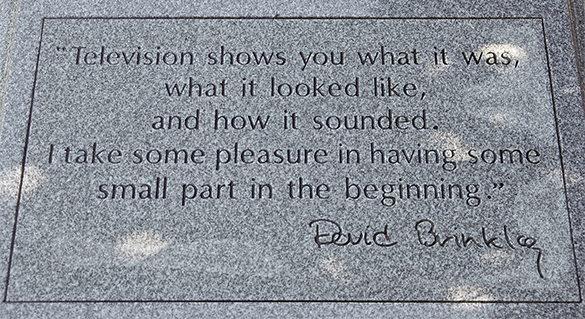
An Epilog
The Reed Sarratt Distinguished Lecture Series brings some of the best and brightest minds in the field of journalism and mass communications to the UNC campus each spring semester to discuss matters of importance and concern. The series was started with two events in 1987 and for its third event, the speaker was David Brinkley.
In addition to his discussion of journalism philosophy and principle, Brinkley shared a humorous story from a time when he was an anchor with NBC News:
Many years ago, when I was doing the Huntley-Brinkley Report, I was in an airport somewhere, and I was approached by a gray-haired lady. She said, “Are you Chet Huntley?” I said, “Yes, I am.” If I had walked up to Abbott and Costello, I’m not sure I would have known which one was which. The woman in the lobby, still thinking she was addressing Huntley, told me she liked me just fine. Then she said but I don’t know how you can stand that idiot Brinkley.
Brinkley was a hit that day at his alma mater, and four years later returned to deliver the commencement address on May 10, 1992.
Happy birthday, Mr. Morton
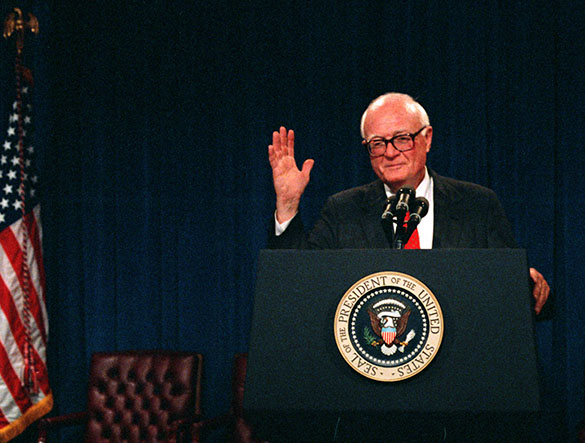
Today marks what would have been Hugh Morton’s 95th birthday. Born on 19 February 1921 in Wilmington, N. C., Morton passed away nearly ten years ago on June 1, 2006 near Grandfather Mountain. To celebrate, why not spend a few minutes exploring the online collection of Morton photographs? You can look for cake, ice cream, and presents (but as an adjective or verb!). There are gifts (or a least gift shops) there, too.
